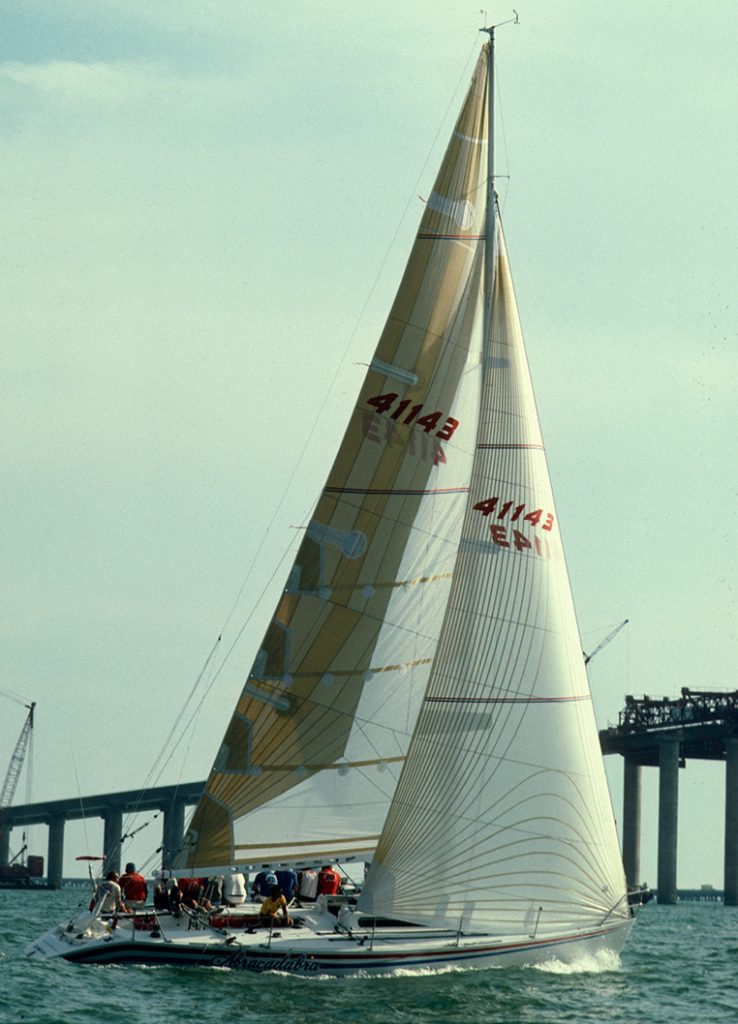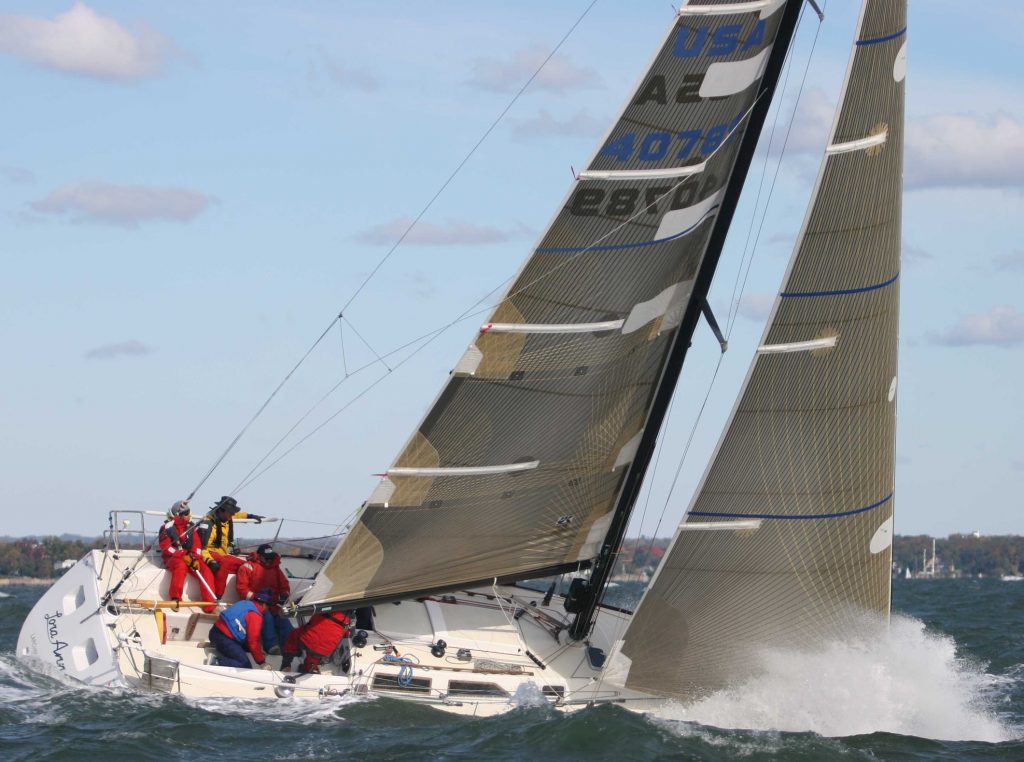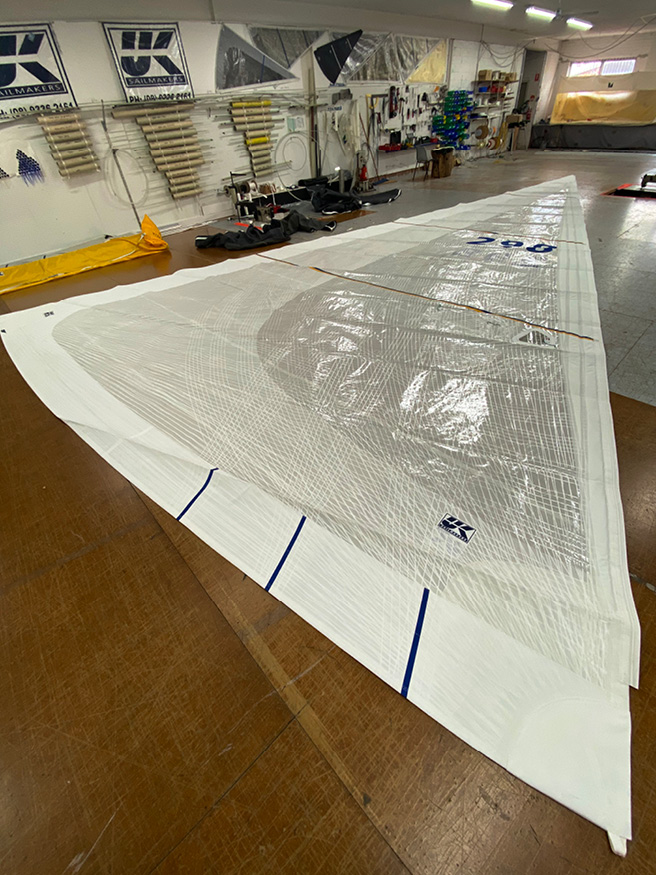An interview with Butch Ulmer
This is the third installment of our conversation with Charles “Butch” Ulmer about the history of the company founded by his father in City Island, New York in 1946. Parts 1 and 2 can be found at windcheckmagazine.com/article/75-years-of-uk-sailmakers/ and windcheckmagazine.com/article/75-years-of-uk-sailmakers-part-2/

The Joubert/Nivelt IOR Two-Tonner Abracadabra with an early Tape Drive® genoa in a Southern Ocean Racing Conference event on Tampa Bay, circa 1986. © uksailmakers.com
WindCheck: Butch, please tell us how you expanded Ulmer Sails beyond the two original lofts in City Island and Annapolis.
Butch Ulmer: When Owen Torrey joined my loft in City Island, we instituted a couple of very significant changes to streamline our sailmaking and to enable us to replicate certain design and construction features in the sails. For instance, we used an early computer to help generate sizes, and we made large Mylar patterns for the edge curves on working sails and for the head and bottom panels of the radial head spinnakers. We started purchasing spinnaker cloth in untrimmed 750-yard rolls instead of the standard 100-yard rolls. Cumulatively, these changes improved our products and our bottom line and it became obvious that these “transferable” improvements might be attractive to other independent sailmakers.
My thinking was simple. Our company had a good name and reputation in the industry and that, along with these tangible improvements in manufacturing, might attract others to our banner. This in turn would make it easier to penetrate other markets and pay for a real advertising program. So we ran a small ad offering Ulmer Sails franchises in a national magazine and we started getting responses immediately. I had a customer who was also an experienced attorney and he quickly wrote up a franchise agreement and we were off and running.
In those days every loft made its own sails, so product consistency from loft to loft was a problem. Every sailmaker in the group was confident that his way of doing something was the best. At the same time, we had the benefit of each loft being independently owned so there was no lack of incentive or initiative.
On paper this all sounded great and it did work but not without a lot of “weeping and gnashing of teeth.” Our annual meetings, which featured a golf outing called the “Ulmer Open,” often became a free-for-all when group agreement was required for things like the ad budget. Nonetheless, the group grew, nationally and internationally, and we became a force in the industry and sport.

Rich du Moulin’s Express 37 Lora Ann has won many races with her UK X-Drive® sails. © uksailmakers.com
During this growth period, I started a loft with an old friend of my father’s, By Baldridge, in Seabrook, Texas. He housed the loft in one of the buildings in his boatyard and found an experienced sailmaker to run it. It ran successfully for a number of years and put our name in a very important market area. However, its biggest contribution was to attract a local young star by the name of John Kolius. John was an Olympic Silver medalist with sailmaking experience, and when he took over the loft things took off.
In roughly the same time frame, Mark Ploch, another young star, started working in the Ulmer Sails loft in Annapolis. After a couple of years, Mark found a defunct loft in Clearwater, Florida and went into business for himself. The result was that Ulmer Sails Group had two good southern lofts run by two of the best young sailor/sailmakers you could find. The company spiraled upward. Mark won the first big J/24 event in Key West and in 1980, John and I sailed together aboard Burt Keenan’s Acadia and we were the overall winner of the SORC.
Soon after this victory roll started, an even bigger opportunity presented itself. There was another successful group of sailmakers operating under the Horizon name. Horizon was started and run by Bob Barton, a smart sailor and good sailmaker. Bob had surrounded himself with some very smart technology people who developed what I think was the first real computer sail design program. They also came up with an intriguing sail construction method which they called Tape-Drive.
Bob successfully turned Horizon into an international group of sailmakers, but unbeknown to me he had business problems that led to the ownership of Horizon ending up in the hands of one of his investors.
When I heard a rumor that the investor was about to move back to his home country in Scandinavia, I called on a whim and asked if he might be interested in selling Horizon. Given my interest in both the product and software, this seemed like it might be a good opportunity. It turned out that he was very interested in selling, and in a matter of a few days we met and came to an agreement. Overnight the Ulmer Sails group had virtually doubled its size with additional lofts in Europe, the U.S., Australia and Asia.
When the smoke cleared, the most significant gains were the Horizon lofts in Chicago and Hong Kong. Chicago was and still is owned and run by Jim Considine and his family. Jim is still active in the loft and to my knowledge, the only member of the UK Group senior to me. His oldest son Pat is UK’s Chief Designer.
Subsequently the Horizon loft in Hong Kong was purchased by Frank Pong, who built it into our major group manufacturing facility. As an aside, when Frank purchased the loft, he did not want to continue doing business under the terms of the Horizon agreement. His representative and I fought about this and just when it looked like we’d be going our separate ways, my phone rang. It was Frank himself. After some small talk, we got down to business and in a matter of two minutes we had a verbal agreement. Frank and I stuck to our words religiously for approximately seven years before we finally met face to face and shook hands on it.

An X-Drive® cruising roller furling genoa nears completion. The white X-Drive® fibers are Edumax, which is from the same chemical family as Spectra and Dyneema. © uksailmakers.com
The years that followed our win in the SORC and led up to the purchase of Horizon were very good for the Ulmer Sails Group but not without lots of trauma, including a couple of name changes. Here’s how that came about:
In 1983, John Kolius was asked to skipper [the 12 Metre] Courageous, the intended trial horse for Defender being skippered by Tom Blackaller. Also, Owen was asked by Tom to be the “Sail Guru” for the syndicate. “Sail Guru” is my term meaning Owen evaluated, recorded and maintained the records for all the sails purchased and used for both boats. Both John and Owen said “Yes” which at the time, we all thought would help elevate the status of our company and give us a boost for future AC business.
The crowning blow came when John asked me to be his tactician. I said, “Yes” but my complete lack of knowledge of match racing quickly became apparent and after two weeks, I went back to minding the store.
John quickly found a capable replacement for me in John Bertrand, and together they sailed Courageous past Defender and went on to sail in the final trials against Dennis Conner to see who would defend the Cup. John lost to Dennis but by the end of the trials, everyone knew his name. Corporately, we decided to take immediate advantage of this hard-earned notoriety and John became President of the Company. We also changed our name to Ulmer-Kolius Sailmakers (name change #1) and adopted a new logo with an italicized UK.
Fast forward a few years to 1987, and it looked like the Ulmer Sails balloon was really on the rise. John was asked to skipper America III, the New York Yacht Club challenger to go to Perth and bring back the Cup. Everything seemed to be falling into place. John Kolius, President of Ulmer-Kolius Sails, skipper for a well-managed, well-funded New York Yacht Club syndicate in a newly designed and built S&S 12 Metre. What could go wrong?
Well, you name it and it went wrong. John lost badly and came home with all the wind out of his sails. The spark of optimism that was his hallmark was gone completely. He resigned as President of UK Sailmakers and left sailmaking. As a group, we were stunned and disappointed. Our balloon had burst! Corporately, we took both names off the door but decided to stick with the italicized letters UK as our logo and name and the UK Sailmakers group was born (name change #2). While our parting was not the happiest of times, John and I have remained friends through it all. ■



